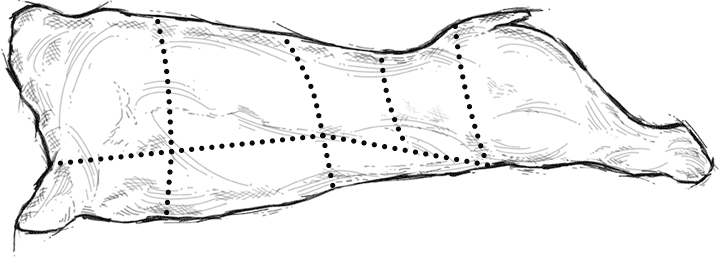Expert Tips
Types of Beef
Types of Beef
USDA Choice, USDA Prime, Kobe beef, Wagyu beef, grass fed, corn fed, dry-aged — you've seen the labels, but what do they all mean?
Problem solved. Here we've pulled together everything you need to know about the different types of beef available. Now you can select your next cut of high quality beef like a pro!
- USDA Beef Grades
The USDA has established uniform standards of quality for beef, based on the traits that affect the meat's tenderness, juiciness, and flavor — primarily the level of marbling (the amount of fat running through the meat) and the age of the animal. Prime grade and Choice grade are the top levels of quality and the grades typically available for retail purchase.
- USDA Prime. Only the top 5 to 6 percent of all beef earns the industry rating of USDA Prime. It comes from young, well-fed cattle. Marbling, which is what gives a steak its juiciness, tenderness and flavor, is exceptional in Prime beef. Perfect for grilling, roasting or broiling.
- USDA Choice. Choice beef is high-quality and has moderate marbling. Choice steak and roasts are juicy, tender and full-flavored, making Choice cuts ideal for grilling, roasting or broiling, but many Choice cuts are terrific for braising as well. Choice beef is the most common grade found at retail.
- Veal
In contrast to the beef from older cattle, Veal is the meat of calves. Most veal comes from young males of dairy breeds who are not used for breeding. Veal is extremely tender and is ideal for a savory meal.
- Kobe Beef, Wagyu Beef and American Style Kobe Beef
You may have heard of the renowned Japanese Wagyu cattle (Wa = Japanese, Gyu = cattle) and the exceptional beef that comes from these animals; that's because they are genetically predisposed to produce heavily marbled meat. There are several different Wagyu breeds and today many are raised in countries beyond Japan, including the U.S. and Australia.
- True Kobe beef must come from the Tajima breed of Wagyu cattle and it must be raised in the Hyogo Prefecture of Japan. Its exceptional flavor and tenderness are accompanied by an equally exceptional price tag. Availability in America is very limited.
- American Style Kobe beef is from cattle raised in the United States and bred from the Japanese Wagyu breeds. Like Japanese Kobe beef, it is exceptionally tender, well-marbled, and flavorful.
- Some believe that Kobe beef and American Style Kobe beef are healthier types of beef because they are high in unsaturated fat, along with high levels of oleic acid, which is believed to lower bad (LDL) cholesterol.
- Aging Beef — Wet Aging vs. Dry Aging
Aging is a process that allows safely stored meat to improve its tenderness and flavor over time, usually 3 to 4 weeks. During that time some of the water in beef evaporates, intensifying its flavor. Additionally, naturally occurring enzymes begin to break down muscle fibers and connective tissues, resulting in very tender beef.
There are two primary methods of aging beef:
- Wet aged beef. This method requires sealing meat in airtight bags and holding them at a refrigerated temperature of 32°F to 34°F for 3 to 4 weeks. During this process, beef flavor is intensified, and natural tenderization takes place.
- Dry aged beef. Dry aging beef requires storing the meat uncovered in refrigerated rooms with controlled humidity and air flow for up to 4 weeks, perhaps even longer. This costly dry aged process results in a distinctive beefy flavor, with tones of nuttiness or cheese-like flavors that some diners enjoy but may be too intense for others.
- Grass Fed Beef vs. Corn Fed Beef
Cattle in the United States spend most of their lives eating grass in pastures. But during the last few weeks, animals can be left to graze on grass, (possibly supplemented with hay), or they may be moved to a feedyard and fed a specific diet of corn and/or grain along with feed ingredients (which include things like potato hulls, sugar beets, hay or forage). Both methods affect the taste and texture of the final meat product.
- Corn or grain-finished beef. Corn fed beef has been popular in America for decades. It is well-marbled with a rich, slightly sweet beef flavor that most Americans are accustomed to and expect.
- Grass-finished beef. Grass fed beef is typically leaner than corn fed and has a distinctive, intense beef flavor. It has a higher percentage of healthy Omega-3 fatty acids and CLA (conjugated linoleic acid) than corn fed beef, so some prefer grass fed beef for health reasons.
Primals & Steaks

- 1
- 2
- 3
- 4
- 5
- 6
- 7
-
1
Chuck
Flat Iron
-
2
Brisket
Brisket
-
3
Rib
Boneless Ribeye
Frenched Bone-In Ribeye
Prime Rib Roast
-
4
Plate
Skirt Steak
-
5
Short Loin
Filet Mignon
Bone-In Tenderloin Filet
Tenderloin Tips/Strips
Tenderloin Medallions
Chateaubriand
T-Bone
Porterhouse
Kansas City Strip
Bone-In Kansas City Strip
-
6
Sirloin
Top Sirloin
Sandwich Steaks -
7
Flank
Flank Steak

